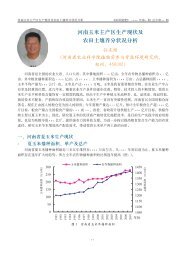Americas and Oceania Group - International Plant Nutrition Institute
Americas and Oceania Group - International Plant Nutrition Institute
Americas and Oceania Group - International Plant Nutrition Institute
You also want an ePaper? Increase the reach of your titles
YUMPU automatically turns print PDFs into web optimized ePapers that Google loves.
Myanmar<br />
Laos<br />
Asia <strong>and</strong> Africa <strong>Group</strong><br />
Thail<strong>and</strong><br />
Vietnam<br />
Cambodia<br />
Malaysia<br />
Philippines<br />
Southeast Asia: Dr. Thomas Oberthür<br />
Indonesia<br />
Best Management Practice for Maximum Economic Yield in Mature Oil Palm<br />
Project Leader: Christopher R. Donough, Consultant Agronomist <strong>and</strong> Oil Palm Breeder, IPNI Southeast Asia Program,<br />
Sabah, Malaysia. E-mail: chrisrd@pd.jaring.my<br />
This project was started in 2006 <strong>and</strong> will continue until 2012 with the main objective of implementing,<br />
testing, <strong>and</strong> refining the Best Management Practice (BMP) concept for yield intensification in order to<br />
increase productivity, profitability, <strong>and</strong> sustainability of palm oil production. BMPs are implemented in five<br />
full-size management blocks in six collaborating plantations in Sumatra (North, South) <strong>and</strong> Kalimantan<br />
(West, Central, <strong>and</strong> East) in existing mature plantings by IPNI <strong>and</strong> its plantation partners. Results from the<br />
BMP implementation are compared to those achieved under st<strong>and</strong>ard plantation practices in five reference<br />
blocks. At the outset of the research, reference <strong>and</strong> BMP blocks had similar conditions <strong>and</strong> performance.<br />
In late 2011, BMP implementation at the six project sites was completed. Yield advantages with BMP were<br />
significant at all project sites except one site where current yield is probably close to the site yield potential.<br />
Results show the robustness of the BMP concept <strong>and</strong> its applicability across a wide range of environmental<br />
<strong>and</strong> operating conditions. Bunch yield with BMP averaged 3.4 t/ha (+15%) higher due to more (+9%) <strong>and</strong><br />
heavier (+6%) bunches. Crop recovery BMPs including a short harvest interval are important for high<br />
bunch yield in the short term, while other agronomic BMPs related to canopy <strong>and</strong> nutrient management are<br />
important for sustained or enhanced yield in the longer term. Cost per unit area is higher with BMP, but<br />
higher BMP yield improves profitability at the farm gate. In the final year of the project, oil <strong>and</strong> kernel yields<br />
are being estimated. Early indications are that oil extraction rate (OER) with BMP is slightly lower as more<br />
frequent harvests result in overall lower number of detached fruits per bunch in the harvested crop. This is not<br />
enough to offset the higher bunch yield with BMP harvesting, so oil yield with BMP is still higher. Priorities<br />
in 2012 include the full analyses of all data collected. Analyses will be conducted with partner universities in<br />
Europe, <strong>and</strong> possibly Southeast Asia. SEA-03<br />
Best Management Practice for Maximum Economic Yield in All Growth Stages of Oil Palm<br />
Project Leader: Chris Donough, IPNI SEAP, Penang, Malaysia. E-mail: crdonough@gmail.com<br />
Project Cooperators: IJM <strong>Plant</strong>ations (Malaysia), Wilmar <strong>International</strong>, (Indonesia), <strong>and</strong> Canpotex <strong>International</strong><br />
This project was started in 2011 <strong>and</strong> will continue until 2018 with an objective to implement, test, <strong>and</strong><br />
refine the Best Management Practice (BMP) concept for yield intensification in order to increase productivity,<br />
profitability, <strong>and</strong> sustainability of palm oil production in all growth stages of oil palm including nursery,<br />
immature <strong>and</strong> mature development phases of the crop. BMPs are implemented in five full-size management<br />
blocks in two collaborating plantations in Sumatra (Indonesia) <strong>and</strong> Sabah (Malaysia) in re-plantings of<br />
existing plantations by IPNI <strong>and</strong> its plantation partners. Results from the BMP implementation are compared<br />
to those achieved under st<strong>and</strong>ard plantation practices in five reference blocks. At the outset of the research,<br />
reference <strong>and</strong> BMP blocks had similar conditions <strong>and</strong> performance.<br />
In late 2011, BMP implementation at the Sabah project site had produced about 70% of the seedlings for<br />
transplanting into the main nursery. The remaining 30% of seedlings will be produced in the pre-nursery<br />
during 2012. In parallel, l<strong>and</strong> preparation for three BMP blocks <strong>and</strong> three reference blocks had started in late<br />
2011. Transplanting of seedlings from the main nursery into the field blocks is expected to start in the second<br />
half of 2012. Currently, the first data are compiled from monitoring of the pre-nursery phase. Databases for<br />
the 8-year project are being designed <strong>and</strong> set up in early 2012. Work on the second site in Sumatra is expected<br />
to start in 2012, depending on the replanting schedule of the plantation partner. This project is unique in its<br />
design as it is including all growth stages of the oil palm <strong>and</strong> proposes as monitoring over a period of 8 years.<br />
SEA–04<br />
IPNI Interpretive Summaries 97

















